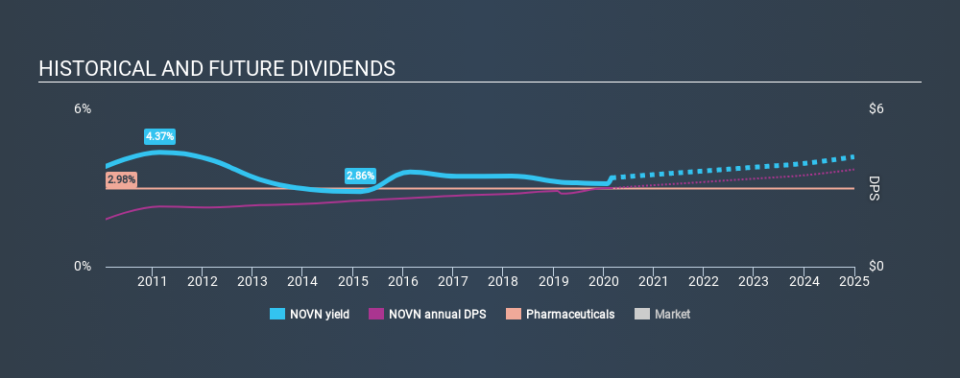Don't Race Out To Buy Novartis AG (VTX:NOVN) Just Because It's Going Ex-Dividend

Regular readers will know that we love our dividends at Simply Wall St, which is why it's exciting to see Novartis AG (VTX:NOVN) is about to trade ex-dividend in the next 4 days. If you purchase the stock on or after the 3rd of March, you won't be eligible to receive this dividend, when it is paid on the 5th of March.
Novartis's upcoming dividend is CHF2.95 a share, following on from the last 12 months, when the company distributed a total of CHF3.00 per share to shareholders. Looking at the last 12 months of distributions, Novartis has a trailing yield of approximately 3.4% on its current stock price of CHF86.44. Dividends are a major contributor to investment returns for long term holders, but only if the dividend continues to be paid. That's why we should always check whether the dividend payments appear sustainable, and if the company is growing.
Check out our latest analysis for Novartis
If a company pays out more in dividends than it earned, then the dividend might become unsustainable - hardly an ideal situation. Novartis paid out 98% of its earnings, which is more than we're comfortable with, unless there are mitigating circumstances. Yet cash flows are even more important than profits for assessing a dividend, so we need to see if the company generated enough cash to pay its distribution. Over the last year it paid out 54% of its free cash flow as dividends, within the usual range for most companies.
It's good to see that while Novartis's dividends were not well covered by profits, at least they are affordable from a cash perspective. Still, if the company continues paying out such a high percentage of its profits, the dividend could be at risk if business turns sour.
Click here to see the company's payout ratio, plus analyst estimates of its future dividends.
Have Earnings And Dividends Been Growing?
When earnings decline, dividend companies become much harder to analyse and own safely. If earnings fall far enough, the company could be forced to cut its dividend. With that in mind, we're discomforted by Novartis's 6.6% per annum decline in earnings in the past five years. Such a sharp decline casts doubt on the future sustainability of the dividend.
The main way most investors will assess a company's dividend prospects is by checking the historical rate of dividend growth. Novartis has delivered 5.2% dividend growth per year on average over the past ten years. That's intriguing, but the combination of growing dividends despite declining earnings can typically only be achieved by paying out a larger percentage of profits. Novartis is already paying out a high percentage of its income, so without earnings growth, we're doubtful of whether this dividend will grow much in the future.
The Bottom Line
Has Novartis got what it takes to maintain its dividend payments? It's never fun to see a company's earnings per share in retreat. Worse, Novartis's paying out a majority of its earnings and more than half its free cash flow. Positive cash flows are good news but it's not a good combination. It's not an attractive combination from a dividend perspective, and we're inclined to pass on this one for the time being.
Curious what other investors think of Novartis? See what analysts are forecasting, with this visualisation of its historical and future estimated earnings and cash flow.
If you're in the market for dividend stocks, we recommend checking our list of top dividend stocks with a greater than 2% yield and an upcoming dividend.
If you spot an error that warrants correction, please contact the editor at editorial-team@simplywallst.com. This article by Simply Wall St is general in nature. It does not constitute a recommendation to buy or sell any stock, and does not take account of your objectives, or your financial situation. Simply Wall St has no position in the stocks mentioned.
We aim to bring you long-term focused research analysis driven by fundamental data. Note that our analysis may not factor in the latest price-sensitive company announcements or qualitative material. Thank you for reading.

